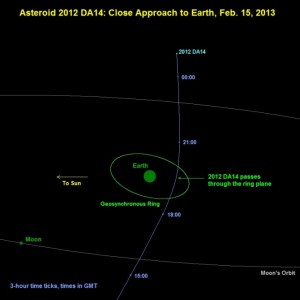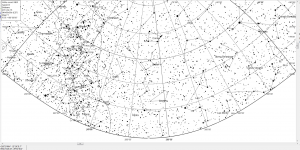Update (4.29 pm AEST): Reports are emerging out of the Urals region of Russia of a meteor being shot down by an air defense unit in the Urzhumka settlement near Chelyabinsk. This story has video from a variety of sources showing what can only be described as a spectacular fireball streaking across the sky. The object could be either a random asteroid entering the Earth’s atmosphere (very small ones do every year) or there is a possibility that the object is related to 2012 DA14 (which is passing the Earth safely tomorrow morning). A large number of asteroids are known to have satellites. Alternatively, IF the asteroid has an orbit that matches that of 2012 DA14, it could be a piece of 2012 DA14 that was knocked off 2012 DA in a collision. Astronomers will be able to calculate this by looking at the video footage. Stay tuned for more….
Update (15 February 2013): Assuming clear skies, NASA will be webcasting the asteroid’s close encounter with the Earth live – including from telescopes in Australia. Closest approach to the Earth will be at 4.25 am AEST on Saturday 16 February 2013 (19.25 pm 15 February 2013 U.T.). A NASA story about webcasting the asteroid flyby can be found here.
(Posted 9 February 2013) Saturday morning (16 February 2013) Australian time, asteroid 2012 DA14 will pass within 27,700 km of the Earth’s surface. 2012 DA is thought to be about 50 meters in diameter and is about the size of the mystery object that exploded above Siberia in 1908 knocking over an estimated 80 million trees down over an area covering 2,150 square kilometers. 2012 DA’s orbit has been measured to kilometer accuracy and such a fate has been ruled out for either the asteroid or the Earth.

What makes 2012 DA14 interesting is that is is the only known close encounter with a ‘relatively’ large asteroid until 13 April 2029 when 99942 Apophis will pass close to the Earth and be visible to the unaided eye as a dim star reaching approximately 3.5 magnitude (if you live in Europe, Africa, and western Asia). That doesn’t mean there won’t be other close encounters with similar sized asteroids before 2029. It just means that we don’t know if one will occur.
2012 DA14’s closeness means that it will temporarily become bright enough to see in a pair of binoculars or a small wide field telescope if you happen to be located on the right part of the Earth’s surface (which Australia is). Peak brightness is expected to reach magnitude 7 for a brief period of time for ideally placed observers (East coast Australia observers will just miss peak brightness) – meaning that at maximum it will only be 2.5 times fainter than the human eye is considered to be able to see under ideal conditions.
There are three catches however. The first is that 2012 DA 14’s close encounter with the Earth is so close that the asteroids encounter with the Earth will shorten its orbital period from 366 to 317 days. This means that charts generated by most commercial astronomy programs won’t show the correct location of 2012 DA because these programs are not written to allow for the Earth’s gravitational effects.
The second catch is parallax. 2012 DA 14 is coming so close to the Earth that observers on different parts of the Earth’s surface will need to look in a slightly different part of the sky to see the asteroid. This means that you need to make sure the chart you are using is made for your location. One made for an observer, say 50 km away will have you looking in a slighly wrong part of the sky.
Finally, 2012 DA14 will be moving fast across the sky. How fast? According to Canberra, Australia based amateur astronomer and astronomy software writer, by 3.45 am AEST on Saturday 16 February, the asteroid will be at mag 7.9 and moving at 2705” per minute or roughly the diameter of the moon in 45 secs!
So to sum up what you will need to have a chance of seeing this asteroid with your own eyes:
- You will need a set of binoculars (larger is better) at least,
- a customised finder chart for your location,
- cloud free skies, and
- the willingness to get up early on a Saturday morning (say 4.00am AEST in the Eastern states of Australia) to look for a faint very quick moving star like object!

The good news is that the Visual SAT-Flare Tracker 3D site will auto-detect your location and generate a finder chart for you. Go here for the dedicated asteroid 2012 DA14 page. The one above is prepared for the Brisbane CBD (and is centred on 4.45am AEST). This may be a little late to be looking as astronomical dawn starts at 4.09 am AEST for Brisbane (Queensland, Australia) on the 16th. I would suggest visiting the Visual SAT-Flare Tracker 3D site and getting it to generate one for your location if you live more than 20 km from the Brisbane CBD.

For those unfamiliar with the sky, I have generated a finder chart for the Western horizon for Brisbane for 4.45 am AEST on Saturday 16 February 2013. I would recommend getting up the morning before to familiarise yourself with the stars 2012 DA14 will be zipping past the next morning.
Good luck!
Hey Paul I went to the Visual SAT-Flare website and tried to recreate your image,
Where exactly did you get 4:45am for Brisbane?
I loaded the 2012 DA14 data into Stellarium and got that it would be visible from sundown Friday night through to 430 am Saturday, SAT-Flare gave me 1800 through 2030 on Friday night?
Little help?
Alex,
Good to hear from you. A couple of answers.
The first is that SAT-Flare recommended the time. I would be looking earlier – say just after 4 am AEST. From Brisbane, astronomical twilight occuers at 4.09 am AEST. After that time , it will be more difficult to spot the asteroid as the sky brightens.
A couple of comments on Stellarium. First of all, it is a fantastic program. One thing it doesn’t do (like most commercial astronomy programs) is cope with calculate the change in an asteroids orbit when it goes close to the Earth – which will happen in the case of this asteroid. Sites like Heavens-Above.com and SAT-Flare run software that can do accurate predictions for this flyby.
Stellarium is right in that 2012 DA14 is in our sky before the time of closest approach. However, it is too faint to be visible to the eye in a large telescope until it is very close to the Earth (due to it’s small size).
Finally, when you use an astronomy program, you need to be aware of if it uses local time or something called universal time (Google it for an explanation). Visual SAT-Flare website uses universal time (which effectively ten hours behind the equivalent local time). I use http://www.timeanddate.com/worldclock/converter.html to convert between the two.
Regards,
Paul Floyd.
AH! Knew i was missing something namely that little GMT sitting beside the time!
Yeah I know Stellarium/etc aren’t proper tracking kits, was still trying to see why the time difference was so far out.
Thanks heaps!
Alex,
Glad to be of help.
Regards,
Paul Floyd.
Anyone budding-Astronomers getting up early on Saturday morning to watch the asteroid pass at 4:45am (Brizzy time)? If so, you’ll need binoculars to see it well. Or see it broadcast here via Nasa and an Aussie observatory 🙂 http://www.ustream.tv/nasajpl2
Here’s some tips if you wanna see it with the naked eye.
http://nightskyonline.info/?p=5758
http://nightskyonline.info/?p=5758
Link in story for Mackay
Sadly it might be raining
:[
Evita,
Don’t forget that NASA will be webcasting the close encounter here: http://www.ustream.tv/nasajpl2
Regards,
Paul Floyd.